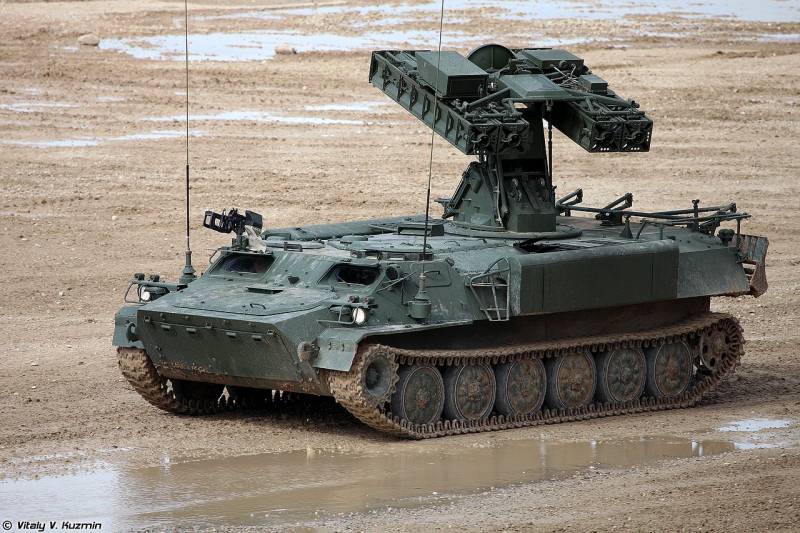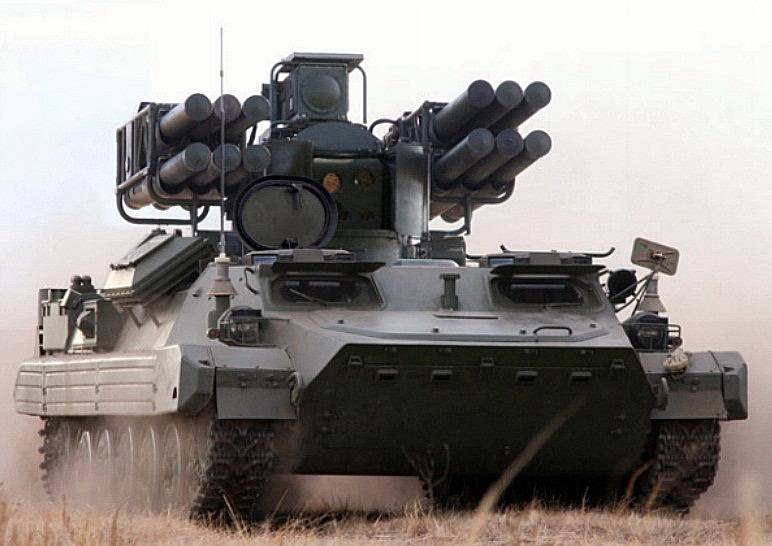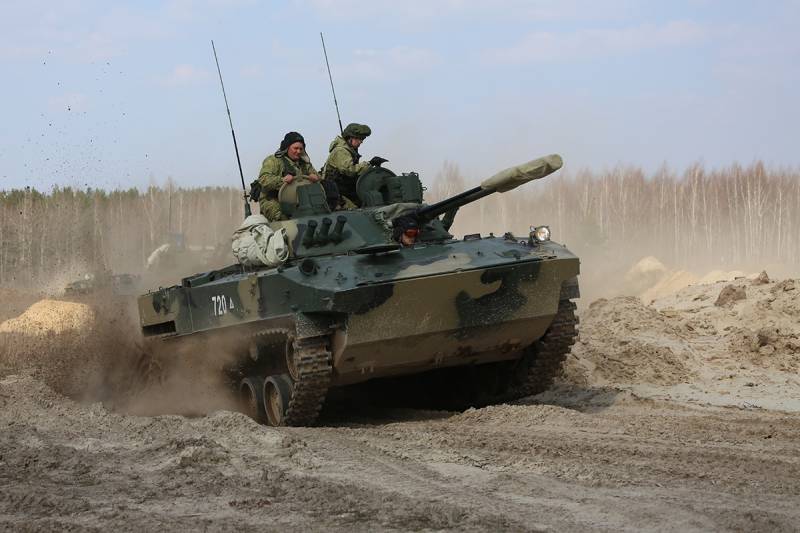The system "Birdies": in the troops from 2022 year
14 March RIA News published statements by the commander of the airborne troops, Colonel-General Andrei Serdyukov, concerning the promising project "Birdies". The commander spoke about current work, the timing of the creation of a new model of military equipment and plans to deploy serial combat vehicles. In his own words, the general added up and corrected the existing picture in a noticeable way.
According to A. Serdyukov, a promising anti-aircraft complex for the Airborne Forces will go into service by 2022. It will be an airborne descent vehicle suitable for transportation with existing military transport equipment aviation. Serial "Poultry" will be reduced to anti-aircraft missile batteries in the regiments of air defense. The latter will be part of the airborne and airborne assault divisions. It is curious that the new complex can be used not only by paratroopers. The possibility of using such equipment in other branches of the army is not ruled out.
At the moment, according to the commander of the Airborne Forces, the new project is at the stage of developing working design documentation. The result of the current stage of work will be the formation of the final appearance of the new air defense system. However, according to RIA Novosti, the base for the new project has already been determined. The anti-aircraft complex will be built on the chassis of the BMD-4M airborne combat vehicle, which will ensure the possibility of transporting equipment by air and parachute landing.
Recent statements by the commander of the airborne troops noticeably change the existing picture, formed by previous messages. In particular, there is reason to believe that the customer and the developers of the “Bird-eaters” project, for unnamed reasons, postponed the deadlines for completing the main works. In addition, the formation of the shape of the future complex has not yet been completed, which is not fully consistent with the older information about the project.
It should be recalled that at the beginning of August last year - shortly after the professional holiday of the airborne troops - the press published some details of the current plans of the military department in respect of the “Birdies” air defense system. The TASS news agency, citing an unnamed source in the defense industry, wrote that the new complex would go into service as early as 2020. It was indicated that at that time the project was at the stage of development work. All such works were planned to be completed by the end of 2019, and in 2020, the finished complex could be put into service.
Now information about the progress of the project "The Birdies" was announced by an official. It turned out that the real plans of the military department are noticeably different from what was reported last year by an unnamed TASS source. So, to date, the project developers have not completed the formation of the appearance of an anti-aircraft complex. Taking into account the subsequent work, the adoption of the equipment for weapons belongs to the 2022 year.
However, certain features of the development of advanced weapons and its coverage in the press do not pay attention to the differences between different messages. The appearance of official statements on the progress of work actually closes the issue, showing the real plans of the military and defense industry.
According to recent data, the project "Birdies" is still at the stage of the formation of the technical appearance. At the same time, work on creating a new anti-aircraft complex for the Airborne Forces has been going on for several years. According to reports from the recent past, in the course of research and development work, the requirements for such a system and, as a result, its approximate shape changed several times. Apparently, now we are talking about creating the final version of the technical image, which will be brought to production and operation.
Recall that the first mention of the creation of a promising anti-aircraft complex for the airborne troops belong to the middle of the 2013 year. Then the domestic press reported that a similar sample of equipment was being created in the Tula Instrument Design Bureau based on the Pantsir-C1 rocket-gun complex. Due to the combined armament, the new complex could hit various targets, and the small dimensions would provide the possibility of being transported by aircraft with a landing or parachute landing. This ZRPK was considered as a potential replacement for the Strela-10, which is in service with the Airborne Forces.
In May 2016, several reports appeared on the development of the air defense system for the airborne forces. According to earlier ones, it was planned to build a new model of the BMD-4M airborne combat vehicle landing gear, which gave certain technical and operational advantages. In addition, at the same time, the name of the project - “The Fowlers” was first published.

The Strela-10М3 complex is the basis of the current air defense of the airborne troops. Photo by Vitalykuzmin.net
Soon, domestic media outlets talked about current work on shaping the future of the “Birdies'” air defense system. It was reported that the Ministry of Defense and enterprises of the industry considered several options for the appearance of the complex. It was proposed to equip the existing chassis with a combat module with rocket armament and sighting equipment. The module could be taken from one of the existing models of equipment, or developed from scratch.
A few weeks later it became known about the start of technical design. At the conclusion of this stage, the industry was to proceed to the next stage of development work. As stated, after the launch of the serial production of the "Birdies" system, they will have to enter service with the airborne anti-aircraft regiments created several years ago. Due to such supplies, gradual replacement of the aging Strela-10 family complexes will be carried out.
At the end of July of the same year, on the eve of the Day of the Airborne Forces, Lieutenant-General Andrei Holzakov, Deputy Commander of the Airborne Forces, again raised the subject of the “Birdies” system. According to him, as part of the implementation of existing plans, already in 2017, the troops were to receive the first copies of the Birdhouse complex and the Typhoon armored car. However, the general did not rule out the possibility of changing such plans for one reason or another.
The next time the "Birdies" SAM system became the topic of news only in August 2017. From last year's message it followed that plans for the delivery of the first models of equipment in the 2017-m will not succeed. However, it was now argued that by the end of 2019, the industry would complete development work and in 2020, the new equipment would go into service. No new information about the technical appearance of the complex was given last year.
According to the latest data announced by the commander of the Airborne Forces, the project is still at the stage of determining the technical appearance. The development work will continue over the next few years, and the Birdies will be in service only in 2022. Such plans look less optimistic than the news of the recent past, but this time it’s about real data from an official.
In the past, starting with 2013, there was an active discussion of the possible appearance of a future anti-aircraft missile system for airborne troops. Naturally, the versions changed in accordance with new progress reports and proposals for the use of certain components. As it became known recently, to date, only one of the aspects of the future project is defined - the base chassis of the future car. However, with certain data, you can try to make a forecast and try to guess the appearance of the future air defense system.
According to first reports, the new complex for the Airborne Forces should have been based on the Panzer missile-gun. However, after a few years, the combat module with combined weapons was abandoned. Now it was about a combat vehicle carrying exclusively short-range missile weapons. As before, it was planned to create a sample suitable for landing in a landing and parachute way.
From a certain time in the context of the "Birdies" air defense system the chassis of the BMD-4M airborne combat vehicle has appeared. To date, this model of armored vehicles was adopted and went into series. Thus, the future release of "Birdies" will not require the production of individual chassis. In addition, the unification is expected to simplify the joint operation of combat vehicles for different purposes, including from the point of view of the organization of transportation and landing.
In the past, it was mentioned that the BMD-4М chassis can install a combat module from the Pine anti-aircraft complex. In this case, the "Birdies" would get a swivel tower with a central support, having an attachment for rocking launchers and a block of optical-electronic equipment. Being a further development of the Strela-10М3 system, the Sosna complex uses optical-electronic surveillance and laser-guided missiles with automatic control of the combat vehicle.
According to open data, the Sinas air defense missile system carries 12 9М337 “Sosna-R” missiles with a mass of 30 kg (42 kg taking into account the transport and launch container). The rocket can accelerate to 900 m / s and maneuver with overload to 40. Laser guidance system provides attack targets at any time of the day. The range of destruction of the complex is from 1300 m to 10 km, altitude - from 2 m to 5 km. The standard equipment of the launcher allows you to independently monitor the airspace or receive external target designation. Depending on the type of target, the range for autotracking reaches 12-14 km.
The Pine air defense missile system successfully completed state tests last year, and should soon be put into service. Serial systems of this type will replace the outdated equipment of the Strela-10 family in the military. In addition, such a complex may be of interest in the context of the re-equipment of the airborne troops. Installing the Sosny combat module on the BMD-4М chassis will provide obvious operational and production advantages while ensuring the required combat potential.

SIRS "Pine" - a possible source of components for the "Ptitselova". Photo Rbase.new-factoria.ru
It cannot be excluded that the existing launcher with search and guidance equipment will need to be improved. The Sosny combat module is not compact and may not meet the requirements for the landing technique.
However, it should be remembered that so far only one of the versions. The final appearance of the "Bird-catcher" has not yet been determined, and therefore may not include the units of the Sinas air defense missile system. It is possible that the Airborne Command decided to order a complex with a completely new combat module. However, the officially announced completion date hints at the use of finished components. Developing the entire complex from scratch would have taken too much time and would not have been completed by 2022.
According to known data, the development program of the air defense system for the airborne troops was launched at least five years ago. Since then, some work has been done, but they still have not led to the desired results. Recent posts on the “Birdies” system may be cause for optimism. After several years of uncertainty, a full-fledged development of the project has started, which should give the desired results in the foreseeable future.
There is reason to believe that until the end of this decade, the industry will continue to design work, and by 2020 a year or later, a prototype of the new Birdie will be put to the test. Thus, after all the necessary checks, the prospective air defense missile system can be adopted by the Airborne Forces in a publicized time frame - in 2022.
In connection with the special tasks of the airborne troops needed equipment with characteristic features. A few years ago, it was decided to strengthen this branch of service with its own anti-aircraft systems, created in accordance with its requirements. The work on the topic “Birdies” has not yet been completed, but it continues and should soon give the desired results. At the beginning of the next decade, the airborne forces will receive new complexes, and in a few years they will be able to obtain the desired equipment in the required quantities and increase their potential.
On the materials of the sites:
https://ria.ru/
https://rg.ru/
http://tass.ru/
http://bastion-karpenko.ru/
http://rbase.new-factoria.ru/

Information